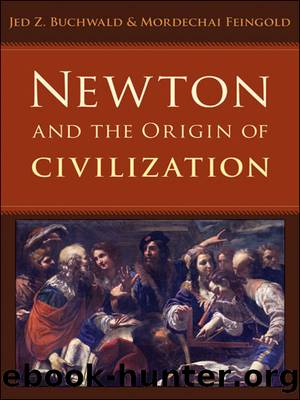Newton and the Origin of Civilization by Buchwald Jed Z.; Feingold Mordechai;

Author:Buchwald, Jed Z.; Feingold, Mordechai;
Language: eng
Format: epub
Publisher: Princeton University Press
Published: 2012-08-14T16:00:00+00:00
equinoctial: mid-Chelae
Chelarum medium secundum latitudinem
equinoctial: right-hand and foreknee of Centaur
Centauri praeterea dextram manum, [et] anteriora genua
equinoctial: flexure of Eridanus
flexum fluminis
equinoctial: head of Cetus
Ceti caput
equinoctial: back of Aries across
Arietis terga secundum latitudinem
equinoctial: head and right hand of Perseus
Persei caput cumdextra manu
a Petau, 1630, pp. 207–8.
The only star catalog remaining from Greco-Roman antiquity had been compiled by Ptolemy and was included in his Almagest.22 That catalog, it had long been thought, was closely connected to Hipparchus’ own, which was otherwise lost.23 There Ptolemy gave tropical coordinates, specifying a star’s longitude—its distance along the ecliptic from the spring equinox—by its position within one of the twelve fixed signs of the zodiac through which the zodiacal constellations (after which the signs were named) move with precession over the centuries. The catalog had been thoroughly updated by Tycho at the turn of the sixteenth century, and most notably thereafter by Hevelius for epoch 1660, who also added eleven new northern constellations.24 Manuals were also published during the seventeenth century that contained star catalogs, as well as information on computational procedures useful for navigation and in some cases for astrology.25 Newton initially used Hevelius’ coordinates in his chronological computations, although apparently he did not own a copy of the 1690 Prodromus. At some point during the 1690s, Newton received from Flamsteed a large set of coordinates26—in the early 1680s he had already obtained several of the Astrononomer Royal’s epoch 1680 coordinates for use in cometary computations, though these would not have been the ones that he needed for the purpose of chronology.27 Figure 8.3, painted with figure 8.2 at Greenwich in 1727 by James Thornhill, places Newton together with Flamsteed, Kepler and Tycho.
Download
This site does not store any files on its server. We only index and link to content provided by other sites. Please contact the content providers to delete copyright contents if any and email us, we'll remove relevant links or contents immediately.
| Archaeology | Essays |
| Historical Geography | Historical Maps |
| Historiography | Reference |
| Study & Teaching |
Underground: A Human History of the Worlds Beneath Our Feet by Will Hunt(11256)
Navigation and Map Reading by K Andrew(4553)
Sapiens by Yuval Noah Harari(4534)
Barron's AP Biology by Goldberg M.S. Deborah T(3630)
The Sympathizer by Viet Thanh Nguyen(3477)
5 Steps to a 5 AP U.S. History, 2010-2011 Edition (5 Steps to a 5 on the Advanced Placement Examinations Series) by Armstrong Stephen(3406)
Three Women by Lisa Taddeo(2918)
The Comedians: Drunks, Thieves, Scoundrels, and the History of American Comedy by Nesteroff Kliph(2790)
Water by Ian Miller(2581)
Drugs Unlimited by Mike Power(2190)
DarkMarket by Misha Glenny(1845)
The House of Government by Slezkine Yuri(1843)
The Library Book by Susan Orlean(1736)
A Short History of Drunkenness by Forsyth Mark(1717)
Revived (Cat Patrick) by Cat Patrick(1677)
The Woman Who Smashed Codes by Jason Fagone(1648)
The House of Rothschild: Money's Prophets, 1798-1848 by Niall Ferguson(1615)
And the Band Played On by Randy Shilts(1615)
Birth by Tina Cassidy(1570)
